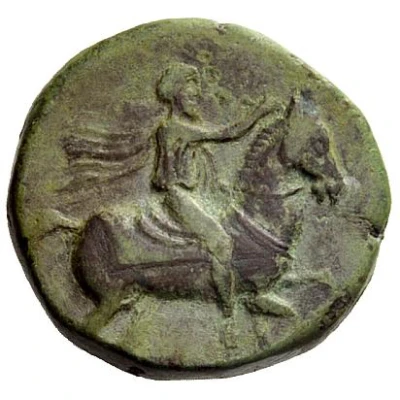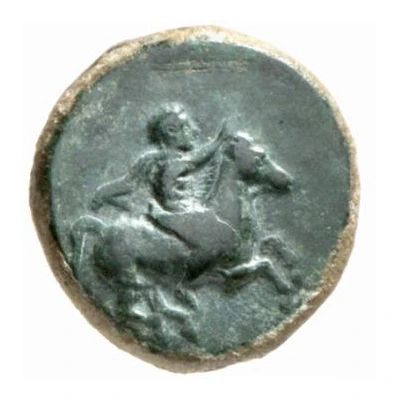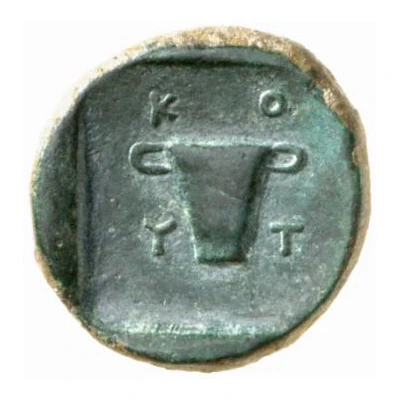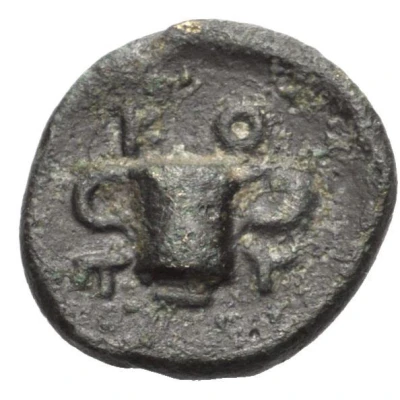


© Numismatica Ars Classica NAC AG
Æ - Kotys Type II; KO T Y 383 BC - 359 BC
| Bronze | 8 g | 20 mm |
| Issuer | Kingdom of Odryssa (Thracians) |
|---|---|
| King | Cotys I (383 BC - 359 BC) |
| Type | Standard circulation coin |
| Years | 383 BC - 359 BC |
| Currency | Drachm |
| Composition | Bronze |
| Weight | 8 g |
| Diameter | 20 mm |
| Shape | Round (irregular) |
| Technique | Hammered |
| Demonetized | Yes |
| Updated | 2024-10-09 |
| Numista | N#238496 |
|---|---|
| Rarity index | 100% |
Reverse
Skyphos (deep wine cup with two handles).
Lettering:
KO
T Y
Comment
Weight varies: 5.42-8.45 g;Diameter varies: 19-21 mm;
Examples of this type:
• Example #1 (8.20 g; Very Fine / Good Very Fine)
©️ Numismatica Ars Classica
◦ Numismatica Ars Classica, Auction 54, 24 March 2010, Lot 763. Estimated at 600 CHF.
• Example #2 (7.45 g; 19 mm; Very Fine)
©️ Solidus Numismatik
◦ Auctioned by Solidus Numismatik, Summer Auction 32, 28 July 2018, Lot 38. Starting price 40 EUR, unsold.
◦ Auctioned by Roma Numismatics Ltd, E-Sale 28, 2 July 2016. Lot 109. Estimated at 200 GBP, unsold.
• Example #3 (7.80 g; 19 mm; Good Fine)
©️ Numismatik Naumann GmbH
◦ Auctioned by Numismatik Naumann, Auction 67, 1 July 2018, Lot 72. Sold for 100 EUR.
• Example #4 (6.89 g; 18 mm; 1 h; Fine, green patina)
©️ Classical Numismatic Group, LLC
◦ Auctioned by Classical Numismatic Group, Electronic Auction 339, 19 November 2014, Lot 34. Sold for 65 USD.
• Example #5 (8.92 g; 21 mm; Very Fine)
©️ Numismatik Naumann GmbH
◦ Auctioned by Numismatik Naumann, Auction 43, 1 May 2016, Lot 183.
◦ Auctioned by Savoca Numismatik, Auction 11, 18 December 2016, Lot 177.
• Example #6 (6.08 g; Fine - Very Fine)
©️ H. D. Rauch GmbH
◦ Auctioned by H. D. Rauch, Summer Auction 2011, 19 September 2011, Lot 110.
Interesting fact
The obverse of the coin features the image of a horse, which was a symbol of strength and power in ancient Thracian culture. The horse was also associated with the goddess Epona, who was revered across the ancient world as a protector of horses and horse-drawn vehicles. The image of the horse on the coin may have been intended to convey the power and prestige of the Odryssian kingdom.



